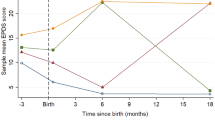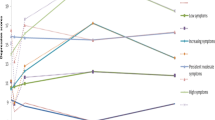Abstract
Children exposed to maternal depression during pregnancy and in the postnatal period are at increased risk of a range of health, wellbeing and development problems. However, few studies have examined the course of maternal depressive symptoms in the perinatal period and beyond on children’s wellbeing. The present study aimed to explore the relationship between both the severity and chronicity of maternal depressive symptoms across the early childhood period and children’s emotional–behavioural difficulties at 4 years of age. Data from over 1,085 mothers and children participating in a large Australian prospective pregnancy cohort were used. Latent class analysis identified three distinct trajectories of maternal depressive symptoms from pregnancy to 4 years postpartum: (1) no or few symptoms (61 %), (2) persistent subclinical symptoms (30 %), and (3) increasing and persistently high symptoms (9 %). Regression analyses revealed that children of mothers experiencing subclinical and increasing and persistently high symptoms were at least two times more likely to have emotional–behavioural difficulties than children of mothers reporting minimal symptoms, even after accounting for known risk factors for poor outcomes for children. These findings challenge policy makers and health professionals to consider how they can tailor care and support to mothers experiencing a broader spectrum of depressive symptoms across the early childhood period, to maximize opportunities to improve both short-and long-term maternal and child health outcomes.

Similar content being viewed by others
References
Schlotz W, Phillips D (2009) Fetal origins of mental health: evidence and mechansims. Brain Behav Immun 23(7):905–916
Downey G, Coyne J (1990) Children of depressed parents: an integrative review. Psychol Bull 108:50–76
Gelfand D, Teti D (1990) The effects of maternal depression on children. Clin Psychol Rev 10(3):329–353
Kingston D, Tough S, Whitfield H (2012) Prenatal and postpartum maternal psychological distress and infant development: a systematic review. Child Psychiatry Hum Dev 43:683–714
Giallo R, Cooklin A, Nicholson J (2014) Risk factors associated with trajectories of mothers’ depressive symptoms across the early parenting period: an Australian-based longitudinal study. Arch Womens Ment Health 17:115–125
Woolhouse H, Gartland D, Mensah F, Brown S (2014) Maternal depression from early pregnancy to 4 years postpartum in a prospective pregnancy cohort study: implications for primary health care. BJOG. doi:10.1111/1471-0528.12837
Priest S, Austin M-P, Barnett B, Buist A (2008) A psychosocial risk assessment model (PRAM) for use with pregnant and postpartum women in primary care settings. Arch Womens Ment Health 11:307–317
Brown S, Lumley J (1998) Changing childbirth: lessons from an Australian survey of 1336 women. BJOG 105:143–155
Gavin N, Gaynes B, Lohr K, Meltzer-Brody S, Gartlehner G, Swinson T (2005) Perinatal depression: a systematic review of prevalence and incidence. Obstet Gyn 106:1071–1083
O’Hara M, Swain A (1996) Rates and risk of postpartum depression: a meta-analysis. Int Rev Psychiatry 8(1):37–54
Horowitz J, Damato E, Solon L, von Metzsch G (1996) Identification of symptoms of postpartum depression: linking researh to practice. J Perinatol 16(5):360–365
Affonso D, Lovett S, Paul S, Sheptak S, Nussbaum R, Newman L, Johnson B (1992) Dysphoric distress in childbearing women. J Perinatol 12(4):325–332
Matthey S, Barnett B, Ungerer J, Waters B (2000) Paternal and maternal depressed mood during the transition to parenthood. J Affect Disord 60:75–85
Beeghly M, Weinberg M, Olson K, Kernan H, Riley J, Tronick E (2002) Stability and change in level of maternal depressive symptomatology during the first postpartum year. J Affect Disord 71:169–180
McCue Horwitz S, Briggs-Gowan M, Storfer-Isser A, Carter A (2007) Prevalence, correlates, and persistence of maternal depression. J Womens Health 16(5):678–691
McLennan J, Kotelchuck M, Cho H (2001) Prevalence, persistence, and correlates of depressive symptoms in a national sample of mothers of toddlers. J Am Acad Child Psychiatry 40(11):1316–1323
Small R, Brown S, Lumley J, Astbury J (1994) Missing voices: what women say and do about depression after childbirth. J Reprod Infant Psychol 12(2):89–103
Cents R, Diamantopoulou S, Hudziak J, Jaddoe V, Hofman F, Verhulst M, Lambregtse-van den Berg M, Tiemeier H (2013) Trajectories of maternal depressive symptoms predict child problem behaviour: the generation R study. Psychol Med 43:13–25
Muthen B (2002) Beyond SEM: general latent variable modeling. Behaviormetrika 29:81–117
Nagin D, Tremblay R (2001) Analyzing developmental trajectories of distinct but related behaviours: a group-based method. Psychol Methods 6:18–34
Mora P, Bennett I, Elo I, Mathew L, Coyne J, Culhane J (2009) Distinct trajectories of perinatal depressive symptomatology: evidence from growth mixture modelling. Am J Epidemiol 169:24–32
Kingston D, Tough S (2013) Prenatal and postnatal maternal mental health and school-age child development: a systematic review. Matern Child Health J (early view)
Brennan P, Hammen C, Andersen M, Bor W, Najman J, Williams G (2000) Chronicity, severity, and timing of maternal depressive symptoms: relationships with child outcomes at age 5. Dev Psychol 36(6):759–766
Early Child Care Research Network (1999) Chronicity of maternal depressive symptoms, maternal sensitivity, and child functioning at 36 months. Dev Psychol 35:1297–1310
Campbell S, Matestic P, von Stauffenberg C, Mohan R, Kirchner T (2007) Trajectories of maternal depressive symptoms, maternal sensitivity, and children’s functioning at school entry. Dev Psychol 43:1202–1215
Campbell S, Morgan-Lopez A, Cox M, McLoyd V (2009) A latent class analysis of maternal depressive symptoms over 12 years and offspring adjustment in adolescence. J Abnorm Psychol 118:479–493
Grant K, Compas B, Sthulmacher A, Thurm A, McMahon S, Halpert J (2003) Stressors and child and adolescent psychopathology: moving form markers to mechanisms of risk. Psychol Bull 129:447–466
Gerard J, Krishnakumar A, Buehler C (2006) Marital conflict, parent-child relations, and youth maladjustment. J Fam Issues 27:951–975
Wake M, Sanson A, Berthelsen D, Hardy P, Mission P, Smith K, Ungerer J, The LSAC Research Consortium (2008) How well are Australian infants and children aged 4–5 years doing? Findings from the Longitudinal Study of Australian Children Wave 1
Sarkadi A, Kristiansson R, Oberklaid F, Bremberg S (2008) Fathers’ involvement and children’s developmental outcomes: a systematic review of longitudinal studies. Acta Paediatr 97:153–158
Brown S, Lumley J, McDonald E, Krastev A (2006) Maternal health study: a prospective cohort study of nulliparous women recruited in early pregnancy. BMC Pregnancy Childbirth 1:12
Cox J, Holden J, Sagovsky R (1987) Detection of postnatal depression. Development of the 10-item Edinburgh postnatal depression scale. Br J Psychiatry 150:782–786
Murray D, Cox J (1990) Screening for depression during pregnancy with the Edinburgh depression scale (EDDS). J Reprod Infant Psychol 8(2):99–107
Goodman R (1997) The strengths and difficulties questionnaire: a research note. J Child Psychol Psychiatry 38:581–586
Goodman R (2001) Psychometric properties of the strengths and difficulties (SDQ). J Am Acad Child Adolesc Psychiatry 40:1337–1345
Hawes D, Dadds M (2004) Australian data and psychometric properties of the Strengths and difficulties questionnaire. Aust NZ J Psychiatry 38:644–651
Colley Gilbert B, Shulman H, Fischer L, Rogers M (1999) The pregnancy risk assessment monitoring system (PRAMS): methods and 1996 response rates from 11 states. Matern Child Health J 3:199–209
Sanson A, Nicholson J, Ungerer J, Zubrick S, Wilson K, Ainley J, Berthelsen D, Bittman M, Broom D, Harrison L, Rodgers B, Sawyer M, Silburn S, Strazdins L (2002) Introducing the longitudinal study of Australian children. Australian Institute of Family Studies, Melbourne
Muthen L, Muthen B (1998–2013) Mplus User’s Guide. Muthen and Muthen, Los Angeles
Belsky J, Pluess M (2009) Beyond diathesis stress: differential susceptibility to environmental influences. Psychol Bull 2009:885–908
Boyce W, Ellis B (2005) Biological sensitivity to context: an evolutionary-developmental theory of the origins and functions of stress reactivity. Dev Psychopathol 17:271–301
Brennan P, Le Brocque R, Hammen C (2003) Maternal depression, parent-child relationships, and resilient outcomes in adolescence. J Am Acad Child Adolesc Psychiatry 42:1469–1477
Acknowledgments
This study was approved by the following human research ethics committees: La Trobe University (2002/38); Royal Women’s Hospital, Melbourne (2002/23); Southern Health, Melbourne (2002-099B; Angliss Hospital, Melbourne (2002), Royal Children’s Hospital, Melbourne (27056A). This research was supported by project grants from the Australian National Health and Medical Research Council (numbers ID191222, ID433006 and ID1048829), a VicHealth Public Health Research Fellowship (2002-2006), a National Health and Medical Research Council Career Development Award (ID491205) and ARC Future Fellowship (IDFT110101036) awarded to S.J.B, and the Victorian Government’s Operational Infrastructure Support Program. We are extremely grateful to the women taking part in the study; to members of the Maternal Health Study Collaborative Group; and to members of the Maternal Health Study research team who have contributed to data collection and coding.
Conflict of interest
On behalf of all authors, the corresponding author states that there is no conflict of interest.
Author information
Authors and Affiliations
Corresponding author
Rights and permissions
About this article
Cite this article
Giallo, R., Woolhouse, H., Gartland, D. et al. The emotional–behavioural functioning of children exposed to maternal depressive symptoms across pregnancy and early childhood: a prospective Australian pregnancy cohort study. Eur Child Adolesc Psychiatry 24, 1233–1244 (2015). https://doi.org/10.1007/s00787-014-0672-2
Received:
Accepted:
Published:
Issue Date:
DOI: https://doi.org/10.1007/s00787-014-0672-2




